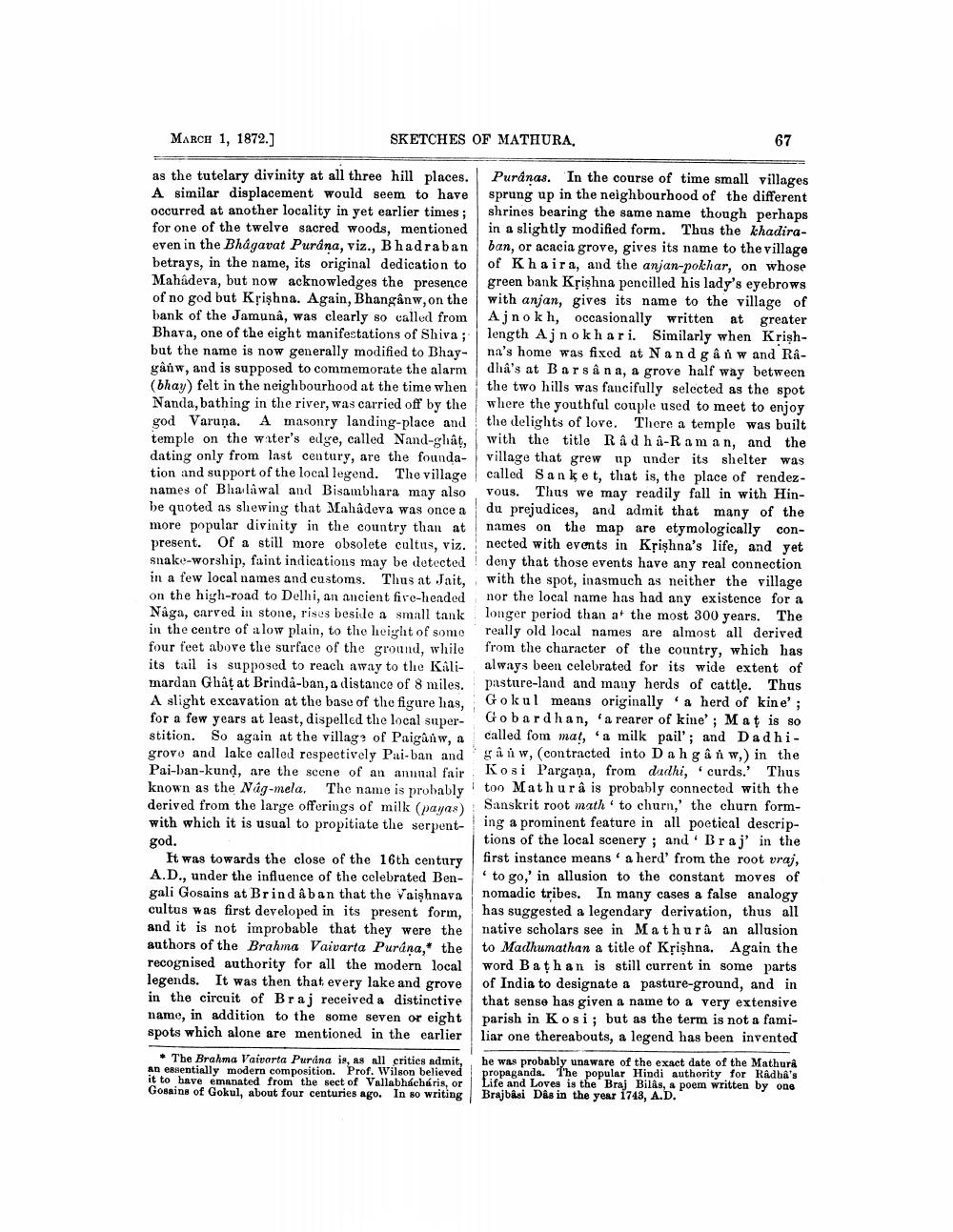________________
MARCH 1, 1872.]
SKETCHES OF MATHURA,
67
as the tutelary divinity at all three hill places. Puranas. In the course of time small villages A similar displacement would seem to have sprung up in the neighbourhood of the different occurred at another locality in yet earlier times; shrinos bearing the same name though perhaps for one of the twelve sacred woods, mentioned in a slightly modified form. Thus the khadiraeven in the Bhagavat Purana, viz., Bhadraban ban, or acacia grove, gives its name to the village betrays, in the name, its original dedication to of Khaira, and the anjan-pokhar, on whose Mahadera, but now acknowledges the presence green bank Krishna pencilled his lady's eyebrows of no god but Krishna. Again, Bhangânw, on the with anjan, gives its name to the village of bank of the Jamunâ, was clearly so called from Ajno kh, occasionally written at greater Bhava, one of the eight manifestations of Shiva ; length Ajnok hari. Similarly when Krishbut the name is now generally modified to Bhay-na's home was fixed at N and gân w and Ragânw, and is supposed to commemorate the alarm dha's at Barsana, a grove half way between (bhay) felt in the neighbourhood at the time when the two hills was fancifully selected as the spot Nanda, bathing in the river, was carried off by the where the youthful couple used to meet to enjoy god Varuņa. A masonry landing-place and the delights of love. There a temple was built temple on the water's edge, called Nand-ghât, with the title Râd hû-R a man, and the dating only from last century, are the founda- village that grew up under its shelter was tion and support of the local legend. The village called Sanket, that is, the place of rendeznames of Bhala wal and Bisambhara may also vous. Thus we may readily fall in with Hinbe quoted as shewing that Mahadeva was once a du prejudices, and admit that many of the more popular divinity in the country than at names on the map are etymologically conpresent. Of a still more obsolete cultus, viz. nected with events in Krishna's life, and yet snake-worship, faint indications may be detected ! deny that those events have any real connection in a few local names and customs. Thus at Jait, with the spot, inasmuch as neither the village on the high-road to Delhi, an ancient fire-headed nor the local name has had any existence for a Någa, carved in stone, rises beside a small tank longer period than at the most 300 years. The in the centre of a low plain, to the height of some really old local names are almost all derived four feet above the surface of the ground, while from the character of the country, which has its tail is supposed to reach away to the Kili- always been celebrated for its wide extent of mardan Ghâț at Brindá-ban, a distance of 8 miles. pasture-land and many herds of cattle. Thus A slight excavation at the base of the figure has, Gokul means originally a herd of kine'; for a few years at least, dispelled the local super- Gobardhan, 'a rearer of kine'; Mat is so stition. So again at the villag, of Paiganw, a called fom mat, 'a milk pail'; and Dadhi. grovo and lake called respectively Pui-ban and raw, (contracted into Da h gå w,) in the Pai-ban-kund, are the scene of an annual fair Kosi Pargana, from dadhi, curds.' Thus known as the Nag-mela. The name is probably too Mathur á is probably connected with the derived from the large offerings of milk payas): Sanskrit root math' to churn,' the churn formwith which it is usual to propitiate the serpent
ing a prominent feature in all poetical descrip
tions of the local scenery; and Braj' in the It was towards the close of the 16th century first instance means ' a herd' from the root vraj, A.D., under the influence of the celebrated Ben- to go,' in allusion to the constant moves of gali Gosains at Brind à ban that the Vaishnava nomadic tribes. In many cases a false analogy cultus was first developed in its present form, has suggested a legendary derivation, thus all and it is not improbable that they were the native scholars see in Mathura an allusion authors of the Brahma Vaivarta Purana, the to Madhumathan a title of Krishna. Again the recognised authority for all the modern local word Bath an is still current in some parts legends. It was then that every lake and grove of India to designate a pasture-ground, and in in the circuit of Braj received a distinctive that sense has given a name to a very extensive name, in addition to the some seven or eight parish in Kosi; but as the term is not a famispots which alone are mentioned in the earlier liar one thereabouts, a legend has been invented
• The Brahma Vaivarta Purina is, as all critics admit, he was probably unaware of the exact date of the Mathura an essentially modern composition. Prof. Wilson believed propaganda. The popular Hindi authority for Radha's it to have emanated from the sect of Vallabhácháris, or Life and Loves is the Braj Bilâs, a poem written by one Gosains of Gokul, about four centuries ago. In so writing | Brajbasi Dis in the year 1743, A.D.
god.




